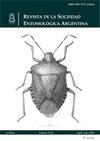丽蝇(直翅目:丽蝇科):生长率、体长差异和最小死后间隔估计的意义
IF 0.5
4区 农林科学
Q4 ENTOMOLOGY
引用次数: 0
摘要
在阿根廷布宜诺斯艾利斯省的寒冷季节,虎尾丽蝇是分解尸体的主要定居物种,占主导地位。使用生长和幼虫长度参数作为死亡后经过时间的准确昆虫学证据来估计最小死后间隔(PMImin)。标本在12、14、16和18°C下饲养,并测定幼虫和蛹的生长速率。记录了发育时间的差异(12°C下43.2天、14°C下34.3天、16°C下29.1天和18°C下24.3天),在较高温度下寿命缩短,幼虫长度范围(~1.5-18.0 mm)不变。温度也影响了成虫的存活率和体型;在14°C(29.73%)和16°C(38.65%)时的存活率最高,在极端温度下的死亡率更高(12°C时为19.00%,18°C时则为12.61%)。在12°C下饲养的成虫是最大的,雌性比雄性长,体型与存活率呈反比。这些结果允许基于当地人口的数据而不是基于其他地区的咨询文件来估计PMI。本文章由计算机程序翻译,如有差异,请以英文原文为准。
Calliphora vicina (Diptera: Calliphoridae): Growth rates, body length differences, and implications for the minimum post-mortem interval estimation
Calliphora vicina Robineau-Desvoidy is a primary colonizing species of decomposing bodies, being predominant in the cold seasons in Buenos Aires province, Argentina. The minimum post-mortem interval (PMImin) was estimated using growth and larval length parameters as the accurate entomological evidence of the elapsed time since death. Specimens were reared at 12, 14, 16, and 18 °C, and the larval and pupal growth rates were determined. Differences in the developmental times were registered (43.2 days at 12 °C, 34.3 days at 14 °C, 29.1 days at 16 °C, and 24.3 days at 18 °C), with the lifespan shortened at higher temperatures, without changing the larval length range (~1.5–18.0 mm). Temperature also influenced the survival and size of emerged adults; the highest percentage of survival registered at 14 (29.73%) and 16 °C (38.65%), and more mortality in extreme temperatures (19.00% at 12 °C and 12.61% at 18 °C). Adults reared at 12 °C were the largest of all, females were longer than males, and body size showed an inverse relationship with survival. These results allowed the PMI estimation based on data from local populations instead of consulting papers based on other regions.
求助全文
通过发布文献求助,成功后即可免费获取论文全文。
去求助
来源期刊

Revista De La Sociedad Entomologica Argentina
Agricultural and Biological Sciences-Insect Science
CiteScore
0.80
自引率
20.00%
发文量
31
审稿时长
20 weeks
 求助内容:
求助内容: 应助结果提醒方式:
应助结果提醒方式:


